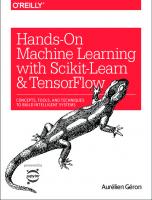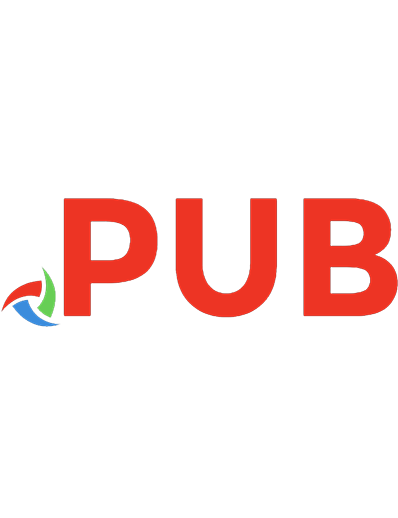Hands-On Machine Learning with Scikit-Learn, Keras, and TensorFlow - Concepts, Tools, and Techniques to Build Intelligent Systems, 2nd Edition [2 ed.] 9781492032649
4,659 943 46MB
English Pages 1109 Year 2019
Table of contents :
Preface
The Machine Learning Tsunami
Machine Learning in Your Projects
Objective and Approach
Prerequisites
Roadmap
Changes in the Second Edition
Other Resources
Conventions Used in This Book
Code Examples
Using Code Examples
O’Reilly Online Learning
How to Contact Us
Acknowledgments
I. The Fundamentals of Machine Learning
1. The Machine Learning Landscape
What Is Machine Learning?
Why Use Machine Learning?
Examples of Applications
Types of Machine Learning Systems
Supervised/Unsupervised Learning
Batch and Online Learning
Instance-Based Versus Model-Based Learning
Main Challenges of Machine Learning
Insufficient Quantity of Training Data
Nonrepresentative Training Data
Poor-Quality Data
Irrelevant Features
Overfitting the Training Data
Underfitting the Training Data
Stepping Back
Testing and Validating
Hyperparameter Tuning and Model Selection
Data Mismatch
Exercises
2. End-to-End Machine Learning Project
Working with Real Data
Look at the Big Picture
Frame the Problem
Select a Performance Measure
Check the Assumptions
Get the Data
Create the Workspace
Download the Data
Take a Quick Look at the Data Structure
Create a Test Set
Discover and Visualize the Data to Gain Insights
Visualizing Geographical Data
Looking for Correlations
Experimenting with Attribute Combinations
Prepare the Data for Machine Learning Algorithms
Data Cleaning
Handling Text and Categorical Attributes
Custom Transformers
Feature Scaling
Transformation Pipelines
Select and Train a Model
Training and Evaluating on the Training Set
Better Evaluation Using Cross-Validation
Fine-Tune Your Model
Grid Search
Randomized Search
Ensemble Methods
Analyze the Best Models and Their Errors
Evaluate Your System on the Test Set
Launch, Monitor, and Maintain Your System
Try It Out!
Exercises
3. Classification
MNIST
Training a Binary Classifier
Performance Measures
Measuring Accuracy Using Cross-Validation
Confusion Matrix
Precision and Recall
Precision/Recall Trade-off
The ROC Curve
Multiclass Classification
Error Analysis
Multilabel Classification
Multioutput Classification
Exercises
4. Training Models
Linear Regression
The Normal Equation
Computational Complexity
Gradient Descent
Batch Gradient Descent
Stochastic Gradient Descent
Mini-batch Gradient Descent
Polynomial Regression
Learning Curves
Regularized Linear Models
Ridge Regression
Lasso Regression
Elastic Net
Early Stopping
Logistic Regression
Estimating Probabilities
Training and Cost Function
Decision Boundaries
Softmax Regression
Exercises
5. Support Vector Machines
Linear SVM Classification
Soft Margin Classification
Nonlinear SVM Classification
Polynomial Kernel
Similarity Features
Gaussian RBF Kernel
Computational Complexity
SVM Regression
Under the Hood
Decision Function and Predictions
Training Objective
Quadratic Programming
The Dual Problem
Kernelized SVMs
Online SVMs
Exercises
6. Decision Trees
Training and Visualizing a Decision Tree
Making Predictions
Estimating Class Probabilities
The CART Training Algorithm
Computational Complexity
Gini Impurity or Entropy?
Regularization Hyperparameters
Regression
Instability
Exercises
7. Ensemble Learning and Random Forests
Voting Classifiers
Bagging and Pasting
Bagging and Pasting in Scikit-Learn
Out-of-Bag Evaluation
Random Patches and Random Subspaces
Random Forests
Extra-Trees
Feature Importance
Boosting
AdaBoost
Gradient Boosting
Stacking
Exercises
8. Dimensionality Reduction
The Curse of Dimensionality
Main Approaches for Dimensionality Reduction
Projection
Manifold Learning
PCA
Preserving the Variance
Principal Components
Projecting Down to d Dimensions
Using Scikit-Learn
Explained Variance Ratio
Choosing the Right Number of Dimensions
PCA for Compression
Randomized PCA
Incremental PCA
Kernel PCA
Selecting a Kernel and Tuning Hyperparameters
LLE
Other Dimensionality Reduction Techniques
Exercises
9. Unsupervised Learning Techniques
Clustering
K-Means
Limits of K-Means
Using Clustering for Image Segmentation
Using Clustering for Preprocessing
Using Clustering for Semi-Supervised Learning
DBSCAN
Other Clustering Algorithms
Gaussian Mixtures
Anomaly Detection Using Gaussian Mixtures
Selecting the Number of Clusters
Bayesian Gaussian Mixture Models
Other Algorithms for Anomaly and Novelty Detection
Exercises
II. Neural Networks and Deep Learning
10. Introduction to Artificial Neural Networks with Keras
From Biological to Artificial Neurons
Biological Neurons
Logical Computations with Neurons
The Perceptron
The Multilayer Perceptron and Backpropagation
Regression MLPs
Classification MLPs
Implementing MLPs with Keras
Installing TensorFlow 2
Building an Image Classifier Using the Sequential API
Building a Regression MLP Using the Sequential API
Building Complex Models Using the Functional API
Using the Subclassing API to Build Dynamic Models
Saving and Restoring a Model
Using Callbacks
Using TensorBoard for Visualization
Fine-Tuning Neural Network Hyperparameters
Number of Hidden Layers
Number of Neurons per Hidden Layer
Learning Rate, Batch Size, and Other Hyperparameters
Exercises
11. Training Deep Neural Networks
The Vanishing/Exploding Gradients Problems
Glorot and He Initialization
Nonsaturating Activation Functions
Batch Normalization
Gradient Clipping
Reusing Pretrained Layers
Transfer Learning with Keras
Unsupervised Pretraining
Pretraining on an Auxiliary Task
Faster Optimizers
Momentum Optimization
Nesterov Accelerated Gradient
AdaGrad
RMSProp
Adam and Nadam Optimization
Learning Rate Scheduling
Avoiding Overfitting Through Regularization
ℓ1 and ℓ2 Regularization
Dropout
Monte Carlo (MC) Dropout
Max-Norm Regularization
Summary and Practical Guidelines
Exercises
12. Custom Models and Training with TensorFlow
A Quick Tour of TensorFlow
Using TensorFlow like NumPy
Tensors and Operations
Tensors and NumPy
Type Conversions
Variables
Other Data Structures
Customizing Models and Training Algorithms
Custom Loss Functions
Saving and Loading Models That Contain Custom Components
Custom Activation Functions, Initializers, Regularizers, and Constraints
Custom Metrics
Custom Layers
Custom Models
Losses and Metrics Based on Model Internals
Computing Gradients Using Autodiff
Custom Training Loops
TensorFlow Functions and Graphs
AutoGraph and Tracing
TF Function Rules
Exercises
13. Loading and Preprocessing Data with TensorFlow
The Data API
Chaining Transformations
Shuffling the Data
Preprocessing the Data
Putting Everything Together
Prefetching
Using the Dataset with tf.keras
The TFRecord Format
Compressed TFRecord Files
A Brief Introduction to Protocol Buffers
TensorFlow Protobufs
Loading and Parsing Examples
Handling Lists of Lists Using the SequenceExample Protobuf
Preprocessing the Input Features
Encoding Categorical Features Using One-Hot Vectors
Encoding Categorical Features Using Embeddings
Keras Preprocessing Layers
TF Transform
The TensorFlow Datasets (TFDS) Project
Exercises
14. Deep Computer Vision Using Convolutional Neural Networks
The Architecture of the Visual Cortex
Convolutional Layers
Filters
Stacking Multiple Feature Maps
TensorFlow Implementation
Memory Requirements
Pooling Layers
TensorFlow Implementation
CNN Architectures
LeNet-5
AlexNet
GoogLeNet
VGGNet
ResNet
Xception
SENet
Implementing a ResNet-34 CNN Using Keras
Using Pretrained Models from Keras
Pretrained Models for Transfer Learning
Classification and Localization
Object Detection
Fully Convolutional Networks
You Only Look Once (YOLO)
Semantic Segmentation
Exercises
15. Processing Sequences Using RNNs and CNNs
Recurrent Neurons and Layers
Memory Cells
Input and Output Sequences
Training RNNs
Forecasting a Time Series
Baseline Metrics
Implementing a Simple RNN
Deep RNNs
Forecasting Several Time Steps Ahead
Handling Long Sequences
Fighting the Unstable Gradients Problem
Tackling the Short-Term Memory Problem
Exercises
16. Natural Language Processing with RNNs and Attention
Generating Shakespearean Text Using a Character RNN
Creating the Training Dataset
How to Split a Sequential Dataset
Chopping the Sequential Dataset into Multiple Windows
Building and Training the Char-RNN Model
Using the Char-RNN Model
Generating Fake Shakespearean Text
Stateful RNN
Sentiment Analysis
Masking
Reusing Pretrained Embeddings
An Encoder–Decoder Network for Neural Machine Translation
Bidirectional RNNs
Beam Search
Attention Mechanisms
Visual Attention
Attention Is All You Need: The Transformer Architecture
Recent Innovations in Language Models
Exercises
17. Representation Learning and Generative Learning Using Autoencoders and GANs
Efficient Data Representations
Performing PCA with an Undercomplete Linear Autoencoder
Stacked Autoencoders
Implementing a Stacked Autoencoder Using Keras
Visualizing the Reconstructions
Visualizing the Fashion MNIST Dataset
Unsupervised Pretraining Using Stacked Autoencoders
Tying Weights
Training One Autoencoder at a Time
Convolutional Autoencoders
Recurrent Autoencoders
Denoising Autoencoders
Sparse Autoencoders
Variational Autoencoders
Generating Fashion MNIST Images
Generative Adversarial Networks
The Difficulties of Training GANs
Deep Convolutional GANs
Progressive Growing of GANs
StyleGANs
Exercises
18. Reinforcement Learning
Learning to Optimize Rewards
Policy Search
Introduction to OpenAI Gym
Neural Network Policies
Evaluating Actions: The Credit Assignment Problem
Policy Gradients
Markov Decision Processes
Temporal Difference Learning
Q-Learning
Exploration Policies
Approximate Q-Learning and Deep Q-Learning
Implementing Deep Q-Learning
Deep Q-Learning Variants
Fixed Q-Value Targets
Double DQN
Prioritized Experience Replay
Dueling DQN
The TF-Agents Library
Installing TF-Agents
TF-Agents Environments
Environment Specifications
Environment Wrappers and Atari Preprocessing
Training Architecture
Creating the Deep Q-Network
Creating the DQN Agent
Creating the Replay Buffer and the Corresponding Observer
Creating Training Metrics
Creating the Collect Driver
Creating the Dataset
Creating the Training Loop
Overview of Some Popular RL Algorithms
Exercises
19. Training and Deploying TensorFlow Models at Scale
Serving a TensorFlow Model
Using TensorFlow Serving
Creating a Prediction Service on GCP AI Platform
Using the Prediction Service
Deploying a Model to a Mobile or Embedded Device
Using GPUs to Speed Up Computations
Getting Your Own GPU
Using a GPU-Equipped Virtual Machine
Colaboratory
Managing the GPU RAM
Placing Operations and Variables on Devices
Parallel Execution Across Multiple Devices
Training Models Across Multiple Devices
Model Parallelism
Data Parallelism
Training at Scale Using the Distribution Strategies API
Training a Model on a TensorFlow Cluster
Running Large Training Jobs on Google Cloud AI Platform
Black Box Hyperparameter Tuning on AI Platform
Exercises
Thank You!
A. Exercise Solutions
Chapter 1: The Machine Learning Landscape
Chapter 2: End-to-End Machine Learning Project
Chapter 3: Classification
Chapter 4: Training Models
Chapter 5: Support Vector Machines
Chapter 6: Decision Trees
Chapter 7: Ensemble Learning and Random Forests
Chapter 8: Dimensionality Reduction
Chapter 9: Unsupervised Learning Techniques
Chapter 10: Introduction to Artificial Neural Networks with Keras
Chapter 11: Training Deep Neural Networks
Chapter 12: Custom Models and Training with TensorFlow
Chapter 13: Loading and Preprocessing Data with TensorFlow
Chapter 14: Deep Computer Vision Using Convolutional Neural Networks
Chapter 15: Processing Sequences Using RNNs and CNNs
Chapter 16: Natural Language Processing with RNNs and Attention
Chapter 17: Representation Learning and Generative Learning Using Autoencoders and GANs
Chapter 18: Reinforcement Learning
Chapter 19: Training and Deploying TensorFlow Models at Scale
B. Machine Learning Project Checklist
Frame the Problem and Look at the Big Picture
Get the Data
Explore the Data
Prepare the Data
Shortlist Promising Models
Fine-Tune the System
Present Your Solution
Launch!
C. SVM Dual Problem
D. Autodiff
Manual Differentiation
Finite Difference Approximation
Forward-Mode Autodiff
Reverse-Mode Autodiff
E. Other Popular ANN Architectures
Hopfield Networks
Boltzmann Machines
Restricted Boltzmann Machines
Deep Belief Nets
Self-Organizing Maps
F. Special Data Structures
Strings
Ragged Tensors
Sparse Tensors
Tensor Arrays
Sets
Queues
G. TensorFlow Graphs
TF Functions and Concrete Functions
Exploring Function Definitions and Graphs
A Closer Look at Tracing
Using AutoGraph to Capture Control Flow
Handling Variables and Other Resources in TF Functions
Using TF Functions with tf.keras (or Not)
Index
![Hands-On Machine Learning with Scikit-Learn, Keras, and TensorFlow - Concepts, Tools, and Techniques to Build Intelligent Systems, 2nd Edition [2 ed.]
9781492032649](https://dokumen.pub/img/200x200/hands-on-machine-learning-with-scikit-learn-keras-and-tensorflow-concepts-tools-and-techniques-to-build-intelligent-systems-2nd-edition-2nbsped-9781492032649.jpg)
![Hands-On Machine Learning with Scikit-Learn, Keras, and Tensorflow: Concepts, Tools, and Techniques to Build Intelligent Systems [Paperback ed.]
1492032646, 9781492032649](https://dokumen.pub/img/200x200/hands-on-machine-learning-with-scikit-learn-keras-and-tensorflow-concepts-tools-and-techniques-to-build-intelligent-systems-paperbacknbsped-1492032646-9781492032649.jpg)
![Hands-on Machine Learning with Scikit-Learn, Keras, and TensorFlow: Concepts, Tools, and Techniques to Build Intelligent Systems [3 ed.]
1492032646, 9781492032649](https://dokumen.pub/img/200x200/hands-on-machine-learning-with-scikit-learn-keras-and-tensorflow-concepts-tools-and-techniques-to-build-intelligent-systems-3nbsped-1492032646-9781492032649.jpg)
![Hands-on machine learning with Scikit-Learn and TensorFlow : concepts, tools, and techniques to build intelligent systems [2nd ed]
9781492032649, 1492032646](https://dokumen.pub/img/200x200/hands-on-machine-learning-with-scikit-learn-and-tensorflow-concepts-tools-and-techniques-to-build-intelligent-systems-2nd-ed-9781492032649-1492032646.jpg)
![Hands-On Machine Learning with Scikit-Learn, Keras, and TensorFlow: Concepts, Tools, and Techniques to Build Intelligent Systems [2nd ed.]
1492032646, 978-1492032649](https://dokumen.pub/img/200x200/hands-on-machine-learning-with-scikit-learn-keras-and-tensorflow-concepts-tools-and-techniques-to-build-intelligent-systems-2ndnbsped-1492032646-978-1492032649.jpg)
![Hands-On Machine Learning with Scikit-Learn and TensorFlow: Concepts, Tools, and Techniques to Build Intelligent Systems [1 ed.]](https://dokumen.pub/img/200x200/hands-on-machine-learning-with-scikit-learn-and-tensorflow-concepts-tools-and-techniques-to-build-intelligent-systems-1nbsped.jpg)



![TensorFlow Machine Learning Cookbook: Over 60 recipes to build intelligent machine learning systems with the power of Python, 2nd Edition [Second edition]
9781789131680, 1789131685, 9781789130768, 178913076X](https://dokumen.pub/img/200x200/tensorflow-machine-learning-cookbook-over-60-recipes-to-build-intelligent-machine-learning-systems-with-the-power-of-python-2nd-edition-second-edition-9781789131680-1789131685-9781789130768-178913076x.jpg)